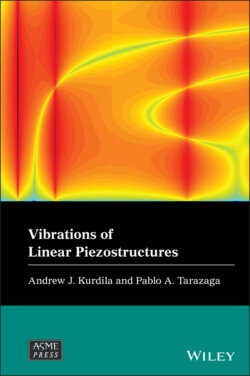Читать книгу Vibrations of Linear Piezostructures - Andrew J. Kurdila - Страница 2
Table of Contents
Оглавление1 Cover
2 Title Page
3 Copyright
4 Foreword
5 Preface
6 Acknowledgments
7 List of Symbols
8 1 Introduction 1.1 The Piezoelectric Effect 1.2 Applications 1.3 Outline of the Book
9 2 Mathematical Background 2.1 Vectors, Bases, and Frames 2.2 Tensors 2.3 Symmetry, Crystals, and Tensor Invariance 2.4 Problems
10 3 Review of Continuum Mechanics 3.1 Stress 3.2 Displacement and Strain 3.3 Strain Energy 3.4 Constitutive Laws for Linear Elastic Materials 3.5 The Initial‐Boundary Value Problem of Linear Elasticity 3.6 Problems
11 4 Review of Continuum Electrodynamics 4.1 Charge and Current 4.2 The Electric and Magnetic Fields 4.3 Maxwell's Equations 4.4 Problems
12 5 Linear Piezoelectricity 5.1 Constitutive Laws of Linear Piezoelectricity 5.2 The Initial‐Value Boundary Problem of Linear Piezoelectricity 5.3 Thermodynamics of Constitutive Laws 5.4 Symmetry of Constitutive Laws for Linear Piezoelectricity 5.5 Problems
13 6 Newton's Method for Piezoelectric Systems 6.1 An Axial Actuator Model 6.2 An Axial, Linear Potential, Actuator Model 6.3 A Linear Potential, Beam Actuator 6.4 Composite Plate Bending 6.5 Problems
14 7 Variational Methods 7.1 A Review of Variational Calculus 7.2 Hamilton's Principle 7.3 Hamilton's Principle for Piezoelectricity 7.4 Bernoulli–Euler Beam with a Shunt Circuit 7.5 Relationship to other Variational Principles 7.6 Lagrangian Densities 7.7 Problems
15 8 Approximations 8.1 Classical, Strong, and Weak Formulations 8.2 Modeling Damping and Dissipation 8.3 Galerkin Approximations 8.4 Problems
16 Supplementary Material S.1 A Review of Vibrations S.2 Tensor Analysis S.3 Distributional and Weak Derivatives
17 Bibliography
18 Index
19 End User License Agreement
